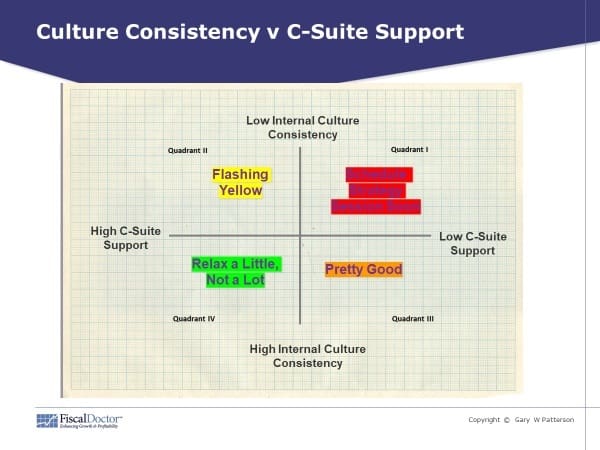Most non-ERM experts don’t really understand the value of integrating a deep understanding of culture. Gary Patterson and Robert Barker share a practical process to improve your visibility into culture.
It is easy to undervalue the culture of trust that builds up over time. Losing the connections between your stakeholders will inevitably lead to losses. Even companies that are on the lookout for cultural issues can be blindsided. No entity is immune – and in a volatile market, a loss of culture can be an existential event.
These thoughts are for every entity — not just for the Fortune 500.
As a case study in our original article showed, a push for innovation and cost efficiencies that ignores culture can result in disaster. We think 12 simple steps can improve your visibility into culture as part of your enterprise risk management (ERM) processes.
Your Culture Framework
The markets are changing and likely to remain exceptionally volatile for some time to come. Whether dealing with international markets, Brexit, the change in the U.S. administration or picking the technological winners and losers in a post-pandemic world while your associates – employees, advisors, managers – work remotely, keeping and maintaining the culture of trust is vital to the continued success of your business.
Where do you think you fit on the chart below? Mark your numerical answer for C-Suite Support on the horizontal continuum from high to low and your answer for Culture Consistency on the vertical continuum. Draw a line between the two points to note your culture and ERM awareness.
Do other major contributors to your company’s success agree with you? If you have broad agreement on a trusting culture, you may only need a few of these steps. If your colleagues do not agree with you – or worse, if you do not know anyone else at your company who is interested in improving the culture – you may need to include more steps or start at the beginning.
Based on which of the four quadrants your business falls into, determine where to begin in the 12-step process that follows.
 12 Steps to Identify Culture Risks
12 Steps to Identify Culture Risks
This 12-step process was created from anonymous comments shared by highly experienced attendees at a recent National Association of Corporate Directors (NACD) Summit. Their insights and suggestions generated 12 transformative steps for improving culture.
Unfortunately, far too many people do not have an accurate picture of their culture risk — like most of us, we do not know what we do not know. Remember that knowing is useful, but third-party validation is a necessary ingredient to understanding. Use the 12 steps below to gain specific knowledge and then create a process to reduce your organization’s risk.
Note: Steps are grouped by quadrant, with a maximum of three actions per quadrant. At the end of each quadrant, consider how well you have applied those steps and whether you are ready to move on to the next set of steps. The process builds on your progress, so reapply steps as needed, and then move on confidently to the next quadrant.
Quadrant I – Schedule Strategy Session Soon (Low C-Suite Support, Low Internal Consistency)
This is the highest level of risk. You may not be failing, but you are at risk. Just scoring your organization in this category can be a good first step toward improvement. Then use these three suggestions as a foundation for moving forward:
- The tone at the top is critical, so get C-Suite (or at least CEO) buy-in to promote change and spur accountability. Even a memo from the CEO will help.
- Appoint a cross-functional group to review and create a plan to address your organization’s top culture exposures and opportunities. This could be part of your annual ERM process (“tone at the top”) for the board.
- If you are lost as to why this is a “blind spot,” hire an external expert to verify and prioritize your internal inventory of vulnerabilities – and opportunities.
Quadrant II – Flashing Yellow (High C-Suite Support, Low Internal Consistency)
Once you have a better understanding of your potential risks and areas for improvement, you can move on to the category “Flashing Yellow.” Quite frankly, this is a common way station. You are now ready to apply the next three suggestions for improvement:
- Involve internal audit and maybe HR and legal in a concerted effort to create the right incentives. Present your plans to the board of directors for input. You would be surprised how supportive they may be.
- Tie incentives to cultural metrics you have identified as metrics for success with your stakeholders. It is easy to get buy-in from HR and legal – not so easy to get it from finance, operations and IT. Make sure the incentives make sense and can be explained.
- Coach cultural underperformers or explain why they would be happier in a different cultural environment; this may require some frank conversations.
Quadrant III – Pretty Good (Low C-Suite Support, High Internal Consistency)
Once you have successfully applied the specific tools and tactics above, your organization can progress toward using culture to enhance your return-on-investment (ROI) level by using these three suggestions:
- Ask whether enhancing culture to the top category is important for your company at this time. What stakeholders benefit, and what disruption may ensue? Weigh the risks and rewards.
- As part of re-evaluating the financial and people resources needed for further improvement, revise and automate procedures, drawing upon external best practices. Again, use your outside consultant as a sounding board.
- Implement specialized training to support the cultural initiatives. But listen from the ground up – pay attention to your customers, employees and shareholders.
Quadrant IV – Relax a Little, Not a Lot (High C-Suite Support, High Internal Consistency)
Whether this was your original rating or your organization has taken the necessary steps to move up to the top category, well done! Enjoy a brief victory lap. Then look at how you can maintain your success and further improve and expand your lead over competitors by using these three suggestions:
- Check to ensure that your strategy, culture and overall supply chain are aligned. Prepare a questionnaire for your customers and employees – be prepared for some critical feedback, but your organization should welcome feedback by this stage.
- Set up a system for ongoing monitoring by creating the appropriate metrics.
- If you have used an external expert who knows your business challenges, bring them back to give your company a “booster shot.” Or hire another third party to validate the work and note the need for improvement. This can take the form of a compliance audit or similar sustainability audits. You may want to explore the work of the SASB or similar organizations in your industry.
Call to Action
Using any of these 12 proven suggestions will help strengthen your organization’s focus on culture and the related areas of ERM, compliance and governance. Review each step; review them with critical team members. Develop a consensus of how to act, and implement the ideas that make the most sense for your organization at this volatile time. Repeat next year.
NACD Summit attendees agree that your business should be able to measure its position before and after following these field-tested steps. With those hard numbers and results, you can then clearly show that improving compliance and governance in this area is not just a cost — it offers a clear ROI.
We live in fast-changing times, and it is not clear that the speed of change will ever be comfortable again for most companies. But by following these steps routinely, your organization will be better positioned to avoid complacency and the challenges of a volatile market.



 Gary W. Patterson, president & CEO of
Gary W. Patterson, president & CEO of  Robert Barker is an attorney living in Atlanta who has practiced in domestic and international M&A, securities and exchange issues. He has served as in-house counsel and outside counsel to corporations for more than 25 years, including advising boards and management teams. Bob can be reached at +01-678-576-3992 or
Robert Barker is an attorney living in Atlanta who has practiced in domestic and international M&A, securities and exchange issues. He has served as in-house counsel and outside counsel to corporations for more than 25 years, including advising boards and management teams. Bob can be reached at +01-678-576-3992 or 









